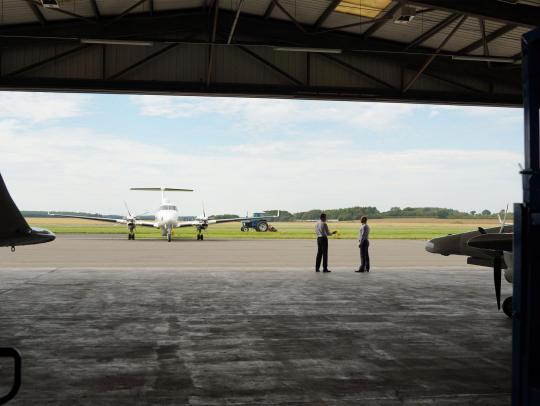The Unique Capabilities of Satellite Communications for Defence and Security

Speech by President and CEO of SES, Karim Michel Sabbagh at the Berlin Security Conference held on Tuesday, 29 November 2016.
Dear Chairman, Ministers and Secretaries of State, distinguished members of this Assembly, Ladies and Gentlemen.
It is a real pleasure for me to be with you here for the second time. This conference has become a key meeting and rendezvous for the European Security and Defence community, and I commend you for holding it.
More than ever today, secure communications matter.
It is vital for maintaining homeland security, protecting the lives of citizens from the threats that have sadly intensified in Europe, managing waves of refugees, and responding to damage caused by natural disasters. Satellite solutions are increasingly the preferred medium of choice for governments seeking the most secure transmission paths and cost effective solutions.
To illustrate this I would like to give you three indicators:
- Firstly, globally the market for government and military fixed satellite service capacity is expected to grow at 3% CAGR over the 2015-2025 period. For High Throughput Satellite capacity, this growth is expected to be even larger, surging from 3 Gbps in 2015 to an expected 115 Gbps in 2025, a 44% CAGR[1].
- Secondly, the exponential growth in Intelligence Surveillance and Reconnaissance (ISR) based on Remotely Piloted Aircraft Systems (RPAS) - for both civil and military uses - acts as a particularly good indicator of the direction of the international government needs. The total number of RPAS used worldwide reached about 29,000 in 2015, more than doubling from 2014[2]. The demanding connectivity requirements of RPAS are also increasing. As an example, while the Predator system requires 3-5 Mbps of bandwidth, the next generation of RPAS are expected to demand over 100 Mbps. As demand for these systems increases, so will the demand for the communications infrastructure that supports them, i.e. satellite.
- Third, SES’s portfolio of international government business has doubled over the past two years and we are proud to serve 57 government customers globally today
To meet this insatiable demand, we are investing in new satellite technology and solutions which will entirely change the scope, applicability and potential of satellite-based constellations and ecosystems and will bring rapidity, agility and security in our collaboration with Governmental users.
Let me expand on the three major features of our new satellite fleet: Rapid Connectivity, Agility and Security.
Rapid Connectivity
The security landscape is shifting and transforming rapidly before our eyes. Enhanced data capabilities are needed for improved situational awareness at multiple levels of command allowing better coordination. Real-time dissemination of still images or full motion video up and down the chain of command is essential to execute the missions more effectively, enabling better-informed life-saving decisions in the field.
Our new satellite fleet will be able to transmit Terabits per second, multiplying on-board traffic by one or more orders of magnitude. We are serving these needs in ground-breaking ways by launching High Throughput Satellites in the GEO orbit at 36,000 km, expanding O3b’s constellation providing low latency and fibre equivalent connectivity from the MEO at 8000 km, and innovating with assured frequency bands with GovSat-1 our newest program as a case in point.
These services are game changers for governments as they will allow them to meet the challenges of running security, defence and civil operations at scale with the highest quality data and video information delivered anywhere it is needed.
Agility
Government and military forces regularly deploy at a moment’s notice, to conduct surveillance operations over large areas such as the Mediterranean, provide disaster response or offer e-health support for disease control in West Africa, among many other urgent global missions. When these surges occur, there simply must be additional agile commercial satellite communications and government satellite communications capacity available, as needed.
The ability to offer high-speed data rates and make efficient use of bandwidth is essential to meeting rising customer expectations. But today it takes more than that ─ it means enabling dynamic, flexible services that can be turned on rapidly and adjusted on demand across the entire global network. We provide the technology building blocks to support true service agility at every point in the process.
Security
Providing high-powered coverage will transform the security environment globally. Future ISR platforms will monitor borders, events and municipalities, while High Definition surveillance platforms on RPAS will develop even further alongside this new satellite technology.
Secure communication for defence and civil use can further be achieved by creating a new and innovative model called governmental satellite communications. This model will allow all European Union Member States to have access to high secured communications networks based on military bands while remaining financially affordable. The first cornerstone within this new model is GovSat, a new venture jointly held by SES and the Luxembourg Government, with its dedicated military band GovSat-1 satellite, planned to be launched in second half of 2017.
Let me provide some examples of the solutions I have mentioned earlier.
1. ISR and RPAS
Command, Control, Communications, Computers, Intelligence Surveillance and Reconnaissance (or C4ISR), manned and unmanned aeronautical platforms as well as other autonomous land and maritime platforms are the key demand drivers of future satellite communications capabilities.
The NATO Alliance Ground Surveillance mandate recently awarded to GovSat (the SES affiliate), is an illustration of how such demand is addressed as an end-to-end secured service. The solution we’re putting in place will support the command & control and sensor data communications required by NATO Global Hawk vehicles over the AGS operational area.
2. Maritime Security Communications
Another important need for RPAS is in the sector of Maritime Security. Maritime Airborne Surveillance combining RPAS and satellite capacity provide flexible solutions to reach-back teleports, provide data management and allow for the distribution of services/imagery on a global scale. Such solutions can satisfy user needs for maritime surveillance missions in terms of detection, location, tracking, recognition and identification of mobile and fixed targets both at sea and on the coastline.
3. Border Control
Beyond Maritime security, commercial satellite communications can give governments persistent situational awareness of weaknesses or threats for border control in particular for the purpose of video screening and obtaining imagery in places where security personnel may not be present.
As an example, SES is supporting the Niger Ministry of Defence with advanced satellite monitoring and communications systems to enhance its current capabilities and support the Nigerian troops in their fight against terrorists on their borders. When not used by the Ministry of Defence, resources are routed to the Nigerian population which can have access to communications technologies, data, eHealth and eEducation services which in turn help Niger to build a growing economy and society.
4. Disaster Relief
Outside of traditional defence and security requirements, European and International organizations leverage our satellite communications in response to humanitarian assistance and disaster relief efforts where other means of communications are not readily available.
Recently, emergency.lu provided connectivity to humanitarian responders following the devastating Hurricane Matthew in Haiti in close collaboration with the World Food Program as global lead of the Emergency Telecommunications Cluster. The emergency.lu terminals use dedicated SES capabilities to re-establish vital communications.
Ladies and Gentlemen, the 2016 White Paper on German Security Policy and the Future of the German army highlights that “Space applications and, in particular, satellite systems are a fundamental component of [German] (….) critical infrastructure. All aspects of national and international communication and navigation decisively depend on them”. I cannot agree more with this.
It is timely that the conference is placed today under the focal point of European security. The publication of this ambitious German White Paper, and the celebration next March of the sixtieth anniversary of the Treaty of Rome, are a symbol and an opportunity to revitalise European defence. I recognize how challenging it is to effect policy changes today in Europe, and as the President and CEO of the world largest satellite operator, I would like that SES contributes in putting the critical satellite infrastructure and solutions in place.
Let me offer a set of recommendations on how to bring increased speed, agility, and security to our collaboration.
While satellite communications are recognised as essential for Common Secure and Defence Policy management operations, the challenge stemming from shrinking defence budgets is aggravated by the fragmentation of European markets, which leads to the unnecessary duplication of capabilities, organisations, and expenditures.
Hence we welcome and encourage Europe to aggregate overall demand and to move towards a coordinated institutional procurement procedure that focuses on longer-term engagements. This will ensure that needs are anticipated, and prepare the right end-to-end solutions to fulfil Europe’s security and defence requirements by involving industry best practices.
Turning to regulation for joint government/commercial programmes, I would encourage the concept of ‘public/private’ investment when pursuing NextGen European broadband Governmental satellite capabilities.
Personally I am ready to work closely with all institutional European stakeholders to define the next generation commercial satellite communications and government satellite communications solutions. At the same time we need to keep in mind that our existing and planned satellite capabilities can already meet many of the applications that will be discussed today. In addition, I would say that any future long-term and innovative space-application programme investments for the European defence and security will require an appropriate and stable legislative environment.
Ladies and Gentlemen, I would like to conclude by reiterating that I remain committed to European Security and Defence. Our differentiated strategy and global scalability are leading us to the generation of new capabilities required to connect the unconnected, offer them a future, manage migration, and meet the security requirements for all European citizens.
Thank you for your attention.
[1] NSR, Government and Military Satellite Communications, 13th Edition, November 2016
[2] Euroconsult, Executive Summary, Prospects for Remotely Piloted Aircraft systems, Market analysis and forecasts, A vertical market analysis of major drivers, key issues and demand take-up, May 2016




